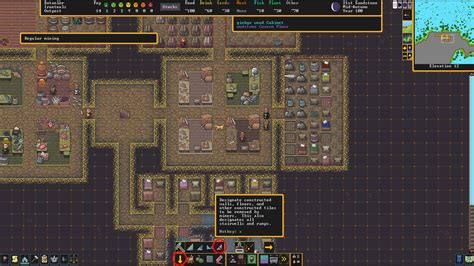| Step 5: Dealing with Post-Removal Cleanup | Conclusion: Embracing the New Open Space |
Welcome to our blog post on the art of removing walls! Whether you are an experienced DIY enthusiast or a novice looking to make some improvements to your living space, understanding how to safely remove walls can open up endless possibilities for creating a more open and spacious environment. In this post, we will take you through a step-by-step guide to removing walls, from preparing your Dwarf Fortress to selecting the right tools and ensuring a safe removal process. We will also discuss dealing with post-removal cleanup and the benefits of embracing the newfound open space. Let’s dive in!
Understanding the Purpose of Removing Walls
The purpose of removing walls in a building or structure can vary depending on the specific situation and desired outcome. However, the most common reasons for removing walls are to create a more open and spacious living or working area, to improve the flow and functionality of a space, and to allow for better natural light and ventilation. Removing walls can also be done for aesthetic purposes, to create an open concept design, or to accommodate specific needs such as accessibility or the installation of new fixtures or equipment.
In some cases, removing a wall may be necessary to address structural issues or to comply with building codes and regulations. For example, if a wall is damaged, unstable, or poses a safety risk, it may need to be removed or replaced. Similarly, when renovating or remodeling a space, removing walls can be a key step in transforming the layout and design to better suit the intended use or to align with current design trends.
Before embarking on a wall removal project, it is important to carefully assess the purpose and impact of the action. This includes considering factors such as the structural integrity of the building, the presence of electrical or plumbing systems within the walls, and any potential impact on neighboring spaces or structures. Consulting with a professional, such as an architect, contractor, or structural engineer, can help ensure that the removal is done safely and in compliance with all applicable regulations.
Step 1: Preparing the Dwarf Fortress
When it comes to removing walls in a Dwarf Fortress, proper preparation is key. Before you begin the process, it’s essential to ensure that you have everything in place to make the task as smooth and efficient as possible. By taking the time to prepare adequately, you’ll be setting yourself up for success and avoiding any potential complications along the way.
One of the first things you should do when preparing the Dwarf Fortress is to assess the overall structure and layout. Take note of the specific walls that you intend to remove and evaluate the potential impact on the surrounding areas. This will help you determine if any additional steps or precautions need to be taken before proceeding with the removal process.
Next, gather the necessary tools and equipment for the job. Depending on the type of walls you’ll be removing, you may need items like a sledgehammer, chisel, pry bar, or even a jackhammer for more substantial structures. It’s important to have these tools readily available and in good working condition to ensure a safe and efficient removal process.
- Make a checklist of all the tools you’ll need
- Ensure the tools are in good condition
- Consider renting or borrowing any specialized equipment
| Tool | Purpose |
|---|---|
| Sledgehammer | To break down walls |
| Chisel | For precise removal or cutting through smaller sections |
| Pry bar | To remove stubborn or stuck portions of walls |
| Jackhammer | For heavy-duty removal of concrete walls |
Lastly, ensure that you have taken the appropriate safety measures before starting the removal process. This includes wearing protective gear such as gloves, safety glasses, and a dust mask to prevent injury and minimize exposure to dust or debris. Additionally, it’s important to have a clear plan in mind and communicate with any other individuals who may be assisting you to avoid any accidents or mishaps during the removal.
By following these steps and adequately preparing your Dwarf Fortress for the wall removal process, you’ll be able to approach the task with confidence and efficiency. Remember to prioritize safety and to be mindful of any potential risks or challenges that may arise along the way. With the right preparation, you’ll be well on your way to successfully removing the walls in your Dwarf Fortress.
Step 2: Identifying the Walls to Remove
When faced with the task of removing walls in your home, it is important to first identify which walls need to be removed. This step is crucial as it helps determine the scope of the project and ensures that the right walls are targeted for removal.
To begin identifying the walls to remove, it is essential to have a clear understanding of the purpose behind removing them. Are you looking to create an open floor plan, enhance natural light flow, or simply update the aesthetics of your space? Once you have a clear goal in mind, you can start assessing the layout of your home to identify the walls that align with your objective.
One way to identify the walls to remove is by considering the function and flow of each room. Walls that divide common areas, such as the living room, dining room, and kitchen, are often the primary candidates for removal. These spaces typically benefit from an open layout that encourages interaction and creates a sense of spaciousness.
- Consider the overall structure of your home:
-   - Load-bearing walls: These walls carry the weight of the structure, and removing them requires careful planning and professional guidance.
-   - Non-load-bearing walls: These walls are not essential for the structural integrity of your home and can be removed with fewer restrictions.
- Evaluate the placement of utilities:
-   - Electrical and plumbing systems within walls may need to be rerouted before removal.
- Pay attention to architectural features:
-   - Arches, columns, or decorative walls can add character to a space, so consider preserving them if they contribute to the overall design.
Once you have identified the walls you wish to remove, it is crucial to consult with a professional contractor or structural engineer. They can assess the feasibility of removing the walls, provide guidance on any necessary reinforcements, and ensure that the project meets safety standards.
| Advantages of Identifying the Walls to Remove: |
|---|
| 1. Enhanced Space: By removing specific walls, you can create a more open and spacious environment in your home, allowing for improved movement and flow. |
| 2. Increased Natural Light: Removing walls can open up the space, allowing more natural light to flow through your home and brighten up dark or poorly lit areas. |
| 3. Improved Social Interaction: An open floor plan encourages communication and socializing, as it eliminates barriers and promotes a sense of togetherness among family members and guests. |
| 4. Enhanced Property Value: Creating an open layout by removing walls can increase the market appeal and value of your home, attracting potential buyers who appreciate open, modern living spaces. |
In conclusion, identifying the walls to remove is a crucial step in any home remodeling project. It requires careful consideration of the purpose behind the removal, evaluation of the layout and functionality of each room, and consultation with professionals. By taking the time to identify the right walls to remove, you can achieve a more open, spacious, and inviting living space.
Step 3: Selecting the Right Tools
In the process of removing walls, selecting the right tools is a crucial step that should not be overlooked. Choosing the appropriate tools for the job can make the task much easier and ensure that the walls are removed safely and efficiently. Here are some important factors to consider when selecting the right tools:
- Size and Type of the Wall: Before selecting the tools, it is important to assess the size and type of the wall that needs to be removed. Different walls may require different tools, so it is essential to understand the specific requirements of the project.
- Tools for Demolition: Depending on the nature of the wall, there are several tools that can be used for demolition. Some common tools include a sledgehammer, demolition hammer, reciprocating saw, or even an angle grinder. The choice of tool will depend on the strength and thickness of the wall.
- Safety Measures: When selecting tools for wall removal, prioritizing safety is of utmost importance. It is essential to choose tools that are not only suitable for the task but also provide necessary safety features. This may include wearing protective gear such as safety goggles, gloves, and a dust mask.
Furthermore, it is worth considering whether manual tools or power tools are more suitable for the project. Manual tools, such as a sledgehammer, may require more physical effort but can be less noisy and may be the preferable option for smaller walls. Power tools, on the other hand, can make the demolition process faster and more efficient, but they might produce more noise and require extra caution during use.
| Tool | Pros | Cons |
|---|---|---|
| Sledgehammer | Effective for small walls | Requires physical effort |
| Demolition Hammer | Powerful and efficient | Can be noisy and difficult to handle |
| Reciprocating Saw | Precision cutting | May cause vibrations |
| Angle Grinder | Fast cutting through various materials | Produces a lot of dust and sparks |
Ultimately, the choice of tools for wall removal depends on various factors such as the size and type of the wall, safety considerations, and personal preferences. It is essential to assess the requirements of the project and select the appropriate tools that will make the task efficient, safe, and successful.
Step 4: Removing the Walls Safely
Removing walls is one of the key steps in any home renovation project. Whether you’re looking to create an open concept living space or simply update the look of a room, taking down walls can make a significant impact. However, it’s crucial to approach this task with caution to ensure safety and avoid any potential damage to the structure of your home. In this blog post, we will discuss step 4 of the wall removal process: removing the walls safely.
When it comes to removing walls, safety should be your top priority. Before you begin, it’s important to identify any electrical or plumbing lines that may be concealed within the wall. This can be done by consulting building plans or hiring a professional to help you locate these potential hazards. By doing so, you can prevent any accidents or damage to important home systems.
Once you have identified potential hazards, it’s time to gather the necessary tools for the task. This step involves selecting the right equipment to safely and efficiently remove the walls. Some essential tools for this process include:
- Protective gear such as gloves, goggles, and hard hats
- A sledgehammer or a heavy-duty hammer
- A prybar or a crowbar
- A reciprocating saw or a circular saw
- Dust masks or respirators
Now that you have the proper tools, it’s time to proceed with the wall removal process. Before you start swinging the sledgehammer, it’s essential to take precautions to minimize potential damage to the surrounding area. Cover the floor with drop cloths or plastic sheets to protect it from falling debris. Additionally, consider using plastic sheeting or temporary walls to create a dust barrier and isolate the work area.
Once you’ve taken these safety measures, it’s time to start removing the walls. Begin by creating small openings in the wall using a hammer or a reciprocating saw. This will help you assess the structure and identify any potential issues before proceeding further. If everything looks good, continue by removing larger sections of the wall by carefully prying or cutting them away.
Throughout the process, it’s important to pay attention to any signs of structural instability. If you notice any sagging, cracking, or shifting in the remaining structure, it’s crucial to stop the work immediately and consult with a professional. They will be able to assess the situation and provide guidance to ensure the safety of your home.
In conclusion, removing walls can be a transformative step in home renovation. However, it’s vital to approach this task with caution and prioritize safety. By identifying potential hazards, selecting the right tools, and taking necessary precautions, you can safely remove walls and achieve your desired results. Remember, when in doubt, it’s always advisable to consult with professionals to ensure a safe and successful renovation.





